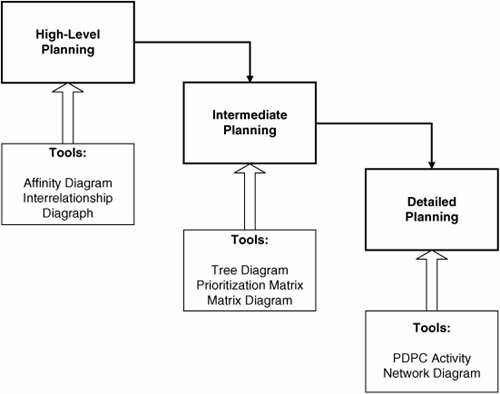| As you will see, the processes involved in 7 MP tools enhance teamwork, communication, and understanding. These tools, when used properly, can explain multifaceted issues and help solve new and complex problems in a planned and systematic manner. They also emphasize managing change systematically and getting the product concept right the first time. Although they can be used separately to address specific issues, they were primarily designed to provide an integrated planning system to identify requirements and develop designs for new and complex products. They are also useful as powerful problem-solving tools. Table 7.2 lists the major applications of these tools. Table 7.2. Typical Applications of 7 MP ToolsTool | Application Recommended |
|---|
Affinity diagram | Widely applicable in problem solving, requirements identification, and design when only worded data are available, especially when You need breakthrough results because old solutions will not work You're dealing with difficult, large, or complex issues Team contribution and support are crucial for implementation success Applying Quality Function Deployment (QFD) (see Chapter 11)
| Interrelationship diagraph (I.D.) | Valuable if quantitative data are unavailable. It overcomes the weakness of a cause-and-effect diagram because it can handle interrelationships and can rank the importance of various issues analyzed. But it requires a lot of time to analyze the problem carefully. Helps in cause-and-effect and goals/means analysis, particularly for: Clarifying complex, difficult, intertwined relationships Identifying most crucial issues and underlying causes Charting correct sequencing of issues with a high degree of uncertainty Establishing facts when historical data are unavailable QFD
| Tree diagram | The tree diagram has wide applications in planning, design, and problem-solving related to complex tasks when details are important for success. It is recommended when risks are anticipated but not easily identifiable and when knowing the sequence of activities in a given task is crucial to success. Specific applications are in Decomposing the problem to be solved into logical components Determining the feasibility and complexity of a possible solution Product development and design Process improvement Quality assurance Analysis of cause-and-effect diagram Problem solving related to cost, quality, efficiency, schedule, and production Developing policy, goals, objectives, tasks, and budget Assigning and prioritizing tasks QFD
| Prioritization matrices[1] | Options generated need to be narrowed down Disagreement exists over the relative importance of solution criteria Limited resources Options generated have strong interrelationships Ranking options and not merely sequencing tasks to be done QFD
| Matrix diagram | New product/service/process design Problem solving Various quality assurance activities Prioritizing among various tasks QFD/Voice of Customer (VOC)
| PDPC | Complex, high-risk/stakes tasks Interdependency of tasks Quality Control (QC) activities New product or process launch Demanding customer schedule FMEA, FMECA, and FTA
| Activity network diagram[a] | Complex tasks Subtasks are known Project is a critical organization target Simultaneous implementation paths must be coordinated Little margin for error in the actual versus estimated time
|
[a] Adapted from Michael Brassard, Memory Jogger Plus + (Methuen: Goal/QPC, 1989), p. 214.
As stated earlier, 7 MP tools are essentially planning tools. Figure 7.1 shows the three different levels of planning and corresponding application of 7 MP tools. Figure 7.1. Levels of Planning and Deployment of 7 MP Tools 
These tools are not recommended in the following circumstances: Problems/tasks are relatively simple and routine. Effective solutions are known and are in use. Quantitative data are available, reliable, and cost-effective. The problem requires a quick solution. A lack of management support for follow-up exists. There's not enough time for analysis. Cost, quality, customer, and risk implications are marginal.
The 7 MP tools are explained in the following sections. |
